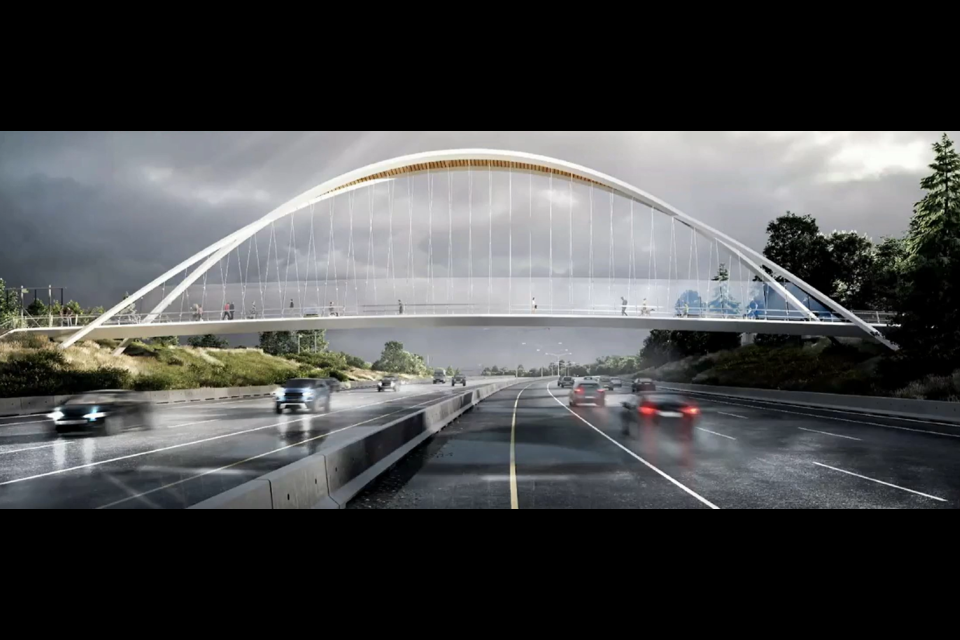A vote on a bike and pedestrian overpass over Highway 1 revealed a rift on Burnaby city council.
At a meeting on Nov. 21, city staff recommended council move forward with the shortest and least expensive route option for the project.
Overpass to connect parks and culture
The overpass will connect Burnaby Lake Regional Park with the cultural centre near Deer Lake, including Burnaby Village Museum and the Burnaby Art Gallery.
Pedestrian and cyclist access to that cultural hub is “severed” by Highway 1, according to the staff presentation at council.
The staff report laid out four options for routes across the highway, including option 1 at Claude Avenue which is the shortest and least expensive, though furthest from the cultural hub.
It’s also the option with the least environmental impact, according to staff.
Options 3 and 4 are the longest, most expensive, and would have the most environmental impact, yet are closer to the hub.
The city needs to begin construction on the project by September 2023, as a requirement of the $6.87 million in federal and provincial funding it received.
Options 3 and 4 were not recommended by staff, as the location involves “poor geotechnical conditions” and would require the relocation of BC Hydro infrastructure.
It could also impact future Highway 1 expansion plans, according to staff.
Burnaby Citizens councillors split
Three Burnaby Citizens Association (BCA) councillors raised concerns about the recommended option 1, questioning whether staff should have received more public feedback regarding the more expensive routes, which cost an estimated $43 million more than the recommended option.
BCA Coun. Sav Dhaliwal, along with BCA councillors James Wang and Pietro Calendino, questioned if enough public engagement had been done to understand the public’s preference on route option.
Dhaliwal and Wang asked if the public had been specifically asked which of the four options were preferred.
Bernard Abelson, senior transportation engineer with McElhanney Ltd. which is working with the city on the project’s report, responded the engagement did not ask that question, but involved presenting what the structures would look like and asked for general input.
Wang asked if people living in the area were consulted, noting he had heard concerns from residents.
Abelson replied all the options are near people’s houses.
Dhaliwal also questioned why the costs were so high for options 3 and 4.
Abelson said it was partially due to the doubling of the price of steel, as well as increased construction costs. Options 3 and 4 use more steel for the longer structures.
Calendino said he preferred options 3 and 4 as they were more in line with the original intent for the overpass to connect the civic facilities on the south side of the freeway to the Burnaby Lake and sports facilities on the north side of the highway.
“This has now morphed, not into a facility to connect the two things, but as a need of another crossing between north and south on the freeway – that wasn’t the original concept,” Calendino said.
Other BCA councillors and mayor in support
Mayor Mike Hurley agreed options 3 and 4 might be preferred, but that council had to be realistic.
“When you look at the reality of how much those are going to cost, I just can’t see anyway you can justify carrying down that path,” he said, calling the overpass “a connector for the whole city.”
“If we want to build a culture of cycling, we have to make it safe,” the mayor said, noting that no parent would let their child ride the Kensington overpass.
He strongly supported option 1.
“It’s an absolute gem of an opportunity to have connectivity in our city, and to have a real cycling spine that we don’t have,” Hurley said, saying option 1 is the “only option that can be considered.”
Three of the six BCA councillors, Alison Gu, Maita Santiago and Daniel Tetrault, spoke in favour of option 1.
“Given that we desperately need more bike and pedestrian infrastructure to connect our city, we need to get this built and done, and construction needs to begin by 2023, so let’s get it built,” Tetrault said.
Green Party Coun. Joe Keithley supported option 1 and suggested it would leave enough money on the table that the city could build a second similar cycle-pedestrian overpass further east over Highway 1.
Council voted in favour of moving forward with option 1 to a detailed design phase. Calendino and Dhaliwal opposed.
Burnaby overpass options for Highway 1
- Option 1: Claude Avenue (estimated cost: $16 million)
- Option 2: Claude Avenue and Wilton Avenue (estimated cost: $19 million)
- Option 3: Sperling Avenue perpendicular crossing (not recommended according to city staff due to Ministry of Transportation constraints and jurisdictional conflicts; estimated cost: $59 million)
- Option 4: Sperling Avenue north-south crossing (not recommended according to city staff due to Ministry of Transportation constraints and jurisdictional conflicts; estimated cost: $59 million)
Vote in our poll: Which Highway 1 pedestrian-bike overpass option do you prefer?





